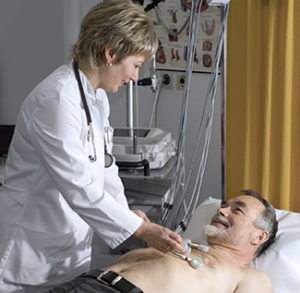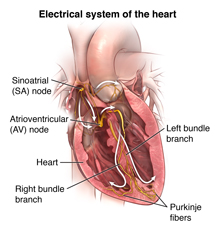What is an electrocardiogram?
 An electrocardiogram (ECG) is one of the simplest and fastest tests used to evaluate the heart. Electrodes (small, plastic patches that stick to the skin) are placed at certain locations on the chest, arms, and legs. When the electrodes are connected to an ECG machine by lead wires, the electrical activity of the heart is measured, interpreted, and printed out. No electricity is sent into the body.
An electrocardiogram (ECG) is one of the simplest and fastest tests used to evaluate the heart. Electrodes (small, plastic patches that stick to the skin) are placed at certain locations on the chest, arms, and legs. When the electrodes are connected to an ECG machine by lead wires, the electrical activity of the heart is measured, interpreted, and printed out. No electricity is sent into the body.
Natural electrical impulses coordinate contractions of the different parts of the heart to keep blood flowing the way it should. An ECG records these impulses to show how fast the heart is beating, the rhythm of the heart beats (steady or irregular), and the strength and timing of the electrical impulses as they move through the different parts of the heart. Changes in an ECG can be a sign of many heart-related conditions.
Why might I need an electrocardiogram?

Some reasons for your doctor to request an electrocardiogram (ECG) include:
- To look for the cause of chest pain
- To evaluate problems which may be heart-related, such as severe tiredness, shortness of breath, dizziness, or fainting
- To identify irregular heartbeats
- To help determine the overall health of the heart prior to procedures such as surgery; and/or after treatment for conditions such as a heart attack (myocardial infarction, or MI), endocarditis (inflammation or infection of one or more of the heart valves); and/or after heart surgery or cardiac catheterization
- To see how an implanted pacemaker is working
- To determine how well certain heart medications are working
- To get a baseline tracing of the heart’s function during a physical exam; this may be used as a comparison with future ECGs, to determine if there have been any changes
There may be other reasons for your doctor to recommend an ECG.
What are the risks of an electrocardiogram?
An electrocardiogram (ECG) is a quick, easy way to assess the heart’s function. Risks associated with ECG are minimal and rare.
You will not feel anything during the ECG, but it may be uncomfortable when the sticky electrodes are taken off. If the electrode patches are left on too long they may cause tissue breakdown or skin irritation.
There may be other risks depending on your specific medical condition. Be sure to discuss any concerns with your doctor prior to the procedure.
Certain factors or conditions may interfere with or affect the results of the ECG. These include, but are not limited to:
- Obesity
- Pregnancy
- Ascites (fluid buildup in the abdomen [belly])
- Anatomical considerations, such as the size of the chest and the location of the heart within the chest
- Movement during the procedure
- Exercise or smoking prior to the procedure
- Certain medications
- Electrolyte imbalances, such as too much or too little potassium, magnesium, and/or calcium in the blood
How do I get ready for an electrocardiogram?
- Your doctor or the technician will explain the procedure to you and let you ask questions.
- Generally, fasting (not eating) is not required before the test.
- Tell your doctor of all medications (prescribed and over-the-counter), vitamins, herbs, and supplements that you are taking.
- Tell your doctor if you have a pacemaker.
- Based on your medical condition, your doctor may request other specific preparation.
What happens during an electrocardiogram?
An electrocardiogram (ECG) may be done on an outpatient basis or as part of your hospital stay. Procedures may vary depending on your condition and your doctor’s practices.
Generally, an ECG follows this process:
- You will be asked to remove any jewelry or other objects that may interfere with the procedure.
- You will be asked to remove clothing from the waist up. The technician will ensure your privacy by covering you with a sheet or gown and exposing only the necessary skin.
- You will lie flat on a table or bed for the procedure. It will be important for you to lie still and not talk during the ECG, so that you don’t alter the tracing.
- If your chest, arms, or legs are very hairy, the technician may shave or clip small patches of hair, as needed, so that the electrodes will stick closely to the skin.
- Electrodes will be attached to your chest, arms, and legs.
- The lead wires will be attached to the electrodes.
- Once the leads are attached, the technician may enter identifying information about you into the machine’s computer.
- The ECG will be started. It will take only a short time for the tracing to be completed.
- Once the tracing is completed, the technician will disconnect the leads and remove the skin electrodes.
What happens after an electrocardiogram?
You should be able to go back to your normal diet and activities, unless your doctor tells you differently.
Generally, there is no special care after an electrocardiogram (ECG).
Tell your doctor if you develop any signs or symptoms you had prior to the ECG (for example, chest pain, shortness of breath, dizziness, or fainting).
Your doctor may give you additional or alternate instructions after the procedure, depending on your particular situation.
Next steps
Before you agree to the test or the procedure make sure you know:
- The name of the test or procedure
- The reason you are having the test or procedure
- The risks and benefits of the test or procedure
- When and where you are to have the test or procedure and who will do it
- When and how will you get the results
- How much will you have to pay for the test or procedure
